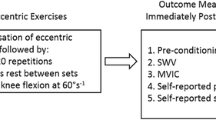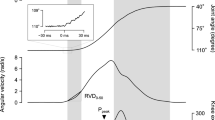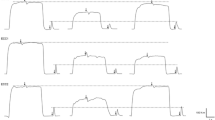Abstract
Purpose
The aim of the study was to examine the changes in the rate of torque development (RTD) as indirect marker of muscle damage following a knee flexion exercise-induced muscle damage protocol in healthy individuals.
Methods
Ten participants (24.8 ± 5.3 years) performed 60 maximal knee flexion eccentric contractions and were evaluated before 0, 24, 48, and 72 h after exercise protocol for maximal isometric and concentric isokinetic strength, optimum angle, RTD, muscle soreness, range of motion (ROM) and biceps femoris and semitendinosus muscle thickness (MT), and echo intensity (EI). RTD was analyzed at 0–50 ms (RTD0–50), 0–100 ms (RTD0–100), 100–200 ms (RTD100–200) windowing, and peak RTD (RTDpeak).
Results
RTD0–50 was decreased (p < 0.05) after 24 h. RTD0–100, RTD100–200, and muscle soreness were decreased after 24, 48, and 72 h after exercise (p < 0.05). RTDpeak, maximal isometric and concentric isokinetic strength decreased and biceps femoris and semitendinosus MT increased (p < 0.05) at all time points after eccentric exercise. ROM was decreased (p < 0.05) 48 and 72 h after exercise. Semitendinosus EI was increased (p < 0.05) 72 h after exercise. Optimum angle was not changed after exercise.
Conclusion
The knee flexor muscle RTD measured at different intervals were changed after the eccentric exercise protocol and may be used as an indirect marker of muscle damage.




Similar content being viewed by others
References
Friden J, Lieber RL (2001) Eccentric exercise-induced injuries to contractile and cytoskeletal muscle fibre components. Acta Physiol Scand 171:321–326
Nosaka K, Chapman D, Newton M, Sacco P (2006) Is isometric strength loss immediately after eccentric exercise related to changes in indirect markers of muscle damage? Applied physiology, nutrition, and metabolism. Physiol Appl Nutr Metabol 31:313–9
Warren GL, Lowe DA, Armstrong RB (1999) Measurement tools used in the study of eccentric contraction-induced injury. Sports Med 27:43–59
Raastad T, Owe SG, Paulsen G et al (2010) Changes in calpain activity, muscle structure, and function after eccentric exercise. Med Sci Sports Exerc 42:86–95
Ingalls CP, Warren GL, Williams JH, Ward CW, Armstrong RB (1998) E-c coupling failure in mouse edl muscle after in vivo eccentric contractions. J Appl Physiol 85:58–67
Penailillo L, Blazevich A, Numazawa H, Nosaka K (2015) Rate of force development as a measure of muscle damage. Scand J Med Sci Sports 25:417–427
Jenkins ND, Housh TJ, Traylor DA et al (2014) The rate of torque development: a unique, non-invasive indicator of eccentric-induced muscle damage? Int J Sports Med 35:1190–1195
Andersen LL, Aagaard P (2006) Influence of maximal muscle strength and intrinsic muscle contractile properties on contractile rate of force development. Eur J Appl Physiol 96:46–52
Chen TC, Lin KY, Chen HL, Lin MJ, Nosaka K (2011) Comparison in eccentric exercise-induced muscle damage among four limb muscles. Eur J Appl Physiol 111:211–223
Sangnier S, Tourny-Chollet C (2007) Comparison of the decrease in strength between hamstrings and quadriceps during isokinetic fatigue testing in semiprofessional soccer players. Int J Sports Med 28:952–957
Macaluso F, Isaacs AW, Myburgh KH (2012) Preferential type ii muscle fiber damage from plyometric exercise. J Athl Train 47:414–420
Korhonen MT, Cristea A, Alen M et al (2006) Aging, muscle fiber type, and contractile function in sprint-trained athletes. J Appl Physiol 101:906–917
Hvid L, Aagaard P, Justesen L et al (2010) Effects of aging on muscle mechanical function and muscle fiber morphology during short-term immobilization and subsequent retraining. J Appl Physiol 109:1628–1634
Farup J, Sorensen H, Kjolhede T (2014) Similar changes in muscle fiber phenotype with differentiated consequences for rate of force development: endurance versus resistance training. Hum Mov Sci 34:109–119
McHugh MP, Connolly DA, Eston RG, Kremenic IJ, Nicholas SJ, Gleim GW (1999) The role of passive muscle stiffness in symptoms of exercise-induced muscle damage. Am J Sports Med 27:594–599
Ayala F, de Baranda PS, De Ste Croix M, Santonja F (2013) Comparison of active stretching technique in males with normal and limited hamstring flexibility. Phys Therapy Sport 14:98–104
Blackburn JT, Pamukoff DN (2014) Geometric and architectural contributions to hamstring musculotendinous stiffness. Clin Biomech 29:105–110
Radaelli R, Bottaro M, Wilhelm EN, Wagner DR, Pinto RS (2012) Time course of strength and echo intensity recovery after resistance exercise in women. J Strength Condition Res 26:2577–2584
Chen CH, Nosaka K, Chen HL, Lin MJ, Tseng KW, Chen TC (2011) Effects of flexibility training on eccentric exercise-induced muscle damage. Med Sci Sports Exerc 43:491–500
Maffiuletti NA, Aagaard P, Blazevich AJ, Folland J, Tillin N, Duchateau J (2016) Rate of force development: physiological and methodological considerations. Eur J Appl Physiol 116:1091–1116
Haff GG, Ruben RP, Lider J, Twine C, Cormie P (2015) A comparison of methods for determining the rate of force development during isometric midthigh clean pulls. J Strength Condition Res 29:386–395
de Ruiter CJ, Kooistra RD, Paalman MI, de Haan A (2004) Initial phase of maximal voluntary and electrically stimulated knee extension torque development at different knee angles. J Appl Physiol 97:1693–1701
Penailillo L, Guzman N, Cangas J, Reyes A, Zbinden-Foncea H (2017) Metabolic demand and muscle damage induced by eccentric cycling of knee extensor and flexor muscles. Eur J Sport Sci 17:179–187
Brusco CM, Blazevich AJ, Radaelli R et al (2018) The effects of flexibility training on exercise-induced muscle damage in young men with limited hamstrings flexibility. Scand J Med Sci Sports 28:1671–1680
Proske U, Allen TJ (2005) Damage to skeletal muscle from eccentric exercise. Exerc Sport Sci Rev 33:98–104
Armstrong RB (1984) Mechanisms of exercise-induced delayed onset muscular soreness: a brief review. Med Sci Sports Exerc 16:529–538
Behrens M, Mau-Moeller A, Bruhn S (2012) Effect of exercise-induced muscle damage on neuromuscular function of the quadriceps muscle. Int J Sports Med 33:600–606
Ferri A, Narici M, Grassi B, Pousson M (2006) Neuromuscular recovery after a strength training session in elderly people. Eur J Appl Physiol 97:272–279
Raastad T, Hallen J (2000) Recovery of skeletal muscle contractility after high- and moderate-intensity strength exercise. Eur J Appl Physiol 82:206–214
Edman KA, Josephson RK (2007) Determinants of force rise time during isometric contraction of frog muscle fibres. J Physiol 580:1007–1019
Warren GL, Ingalls CP, Lowe DA, Armstrong RB (2002) What mechanisms contribute to the strength loss that occurs during and in the recovery from skeletal muscle injury? J Orthop Sports Phys Ther 32:58–64
Crameri RM, Aagaard P, Qvortrup K, Langberg H, Olesen J, Kjaer M (2007) Myofibre damage in human skeletal muscle: effects of electrical stimulation versus voluntary contraction. J Physiol 583:365–380
Raastad T, Risoy BA, Benestad HB, Fjeld JG, Hallen J (2003) Temporal relation between leukocyte accumulation in muscles and halted recovery 10–20 h after strength exercise. J Appl Physiol 95:2503–2509
Taekema DG, Westendorp RG, Frolich M, Gussekloo J (2007) High innate production capacity of tumor necrosis factor-alpha and decline of handgrip strength in old age. Mech Ageing Dev 128:517–521
Folland JP, Buckthorpe MW, Hannah R (2014) Human capacity for explosive force production: neural and contractile determinants. Scand J Med Sci Sports 24:894–906
Chen TC, Nosaka K, Sacco P (2007) Intensity of eccentric exercise, shift of optimum angle, and the magnitude of repeated-bout effect. J Appl Physiol 102:992–999
Caresio C, Molinari F, Emanuel G, Minetto MA (2015) Muscle echo intensity: reliability and conditioning factors. Clin Physiol Funct Imaging 35:393–403
Schuermans J, Van Tiggelen D, Danneels L, Witvrouw E (2014) Biceps femoris and semitendinosus–teammates or competitors? New insights into hamstring injury mechanisms in male football players: a muscle functional mri study. Br J Sports Med 48:1599–1606
Funding
PhD scholarship to Clarissa M Brusco was provided by the Coordenação de Aperfeiçoamento de Pessoal de Nível Superior (CAPES) –Brazil (88887.357700/2019-00).
Author information
Authors and Affiliations
Contributions
C.M.B., R.R., L.E.P., and R.S.P. participated in the conception and design of the study. C.M.B. and R.R. did the data acquisition. All authors participated in data analysis and interpretation and wrote the main manuscript. The manuscript was reviewed and approved by all authors.
Corresponding author
Ethics declarations
Conflict of interest
The authors declare no conflict of interest.
Ethical approval
Ethics approval was given by the Ethics committee of the Universidade Federal do Rio Grande do Sul, approval number 965.097.
Informed consent
The participants were carefully informed of the purpose, procedures, and risks of study participation, and written informed consent was obtained from all participants before commence of the study.
Additional information
Publisher's Note
Springer Nature remains neutral with regard to jurisdictional claims in published maps and institutional affiliations.
Rights and permissions
About this article
Cite this article
Brusco, C.M., Radaelli, R., Neske, R. et al. Rate of torque development as an indirect marker of muscle damage in the knee flexors. Sport Sci Health 18, 75–83 (2022). https://doi.org/10.1007/s11332-021-00776-1
Received:
Accepted:
Published:
Issue Date:
DOI: https://doi.org/10.1007/s11332-021-00776-1




